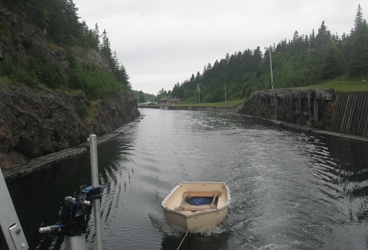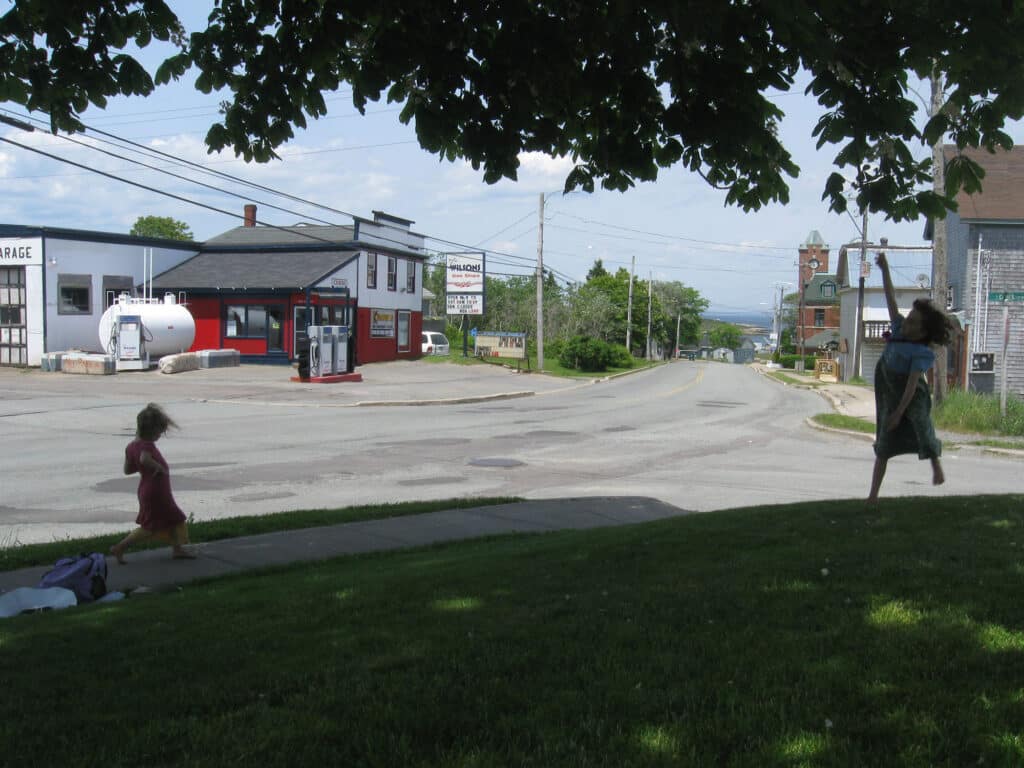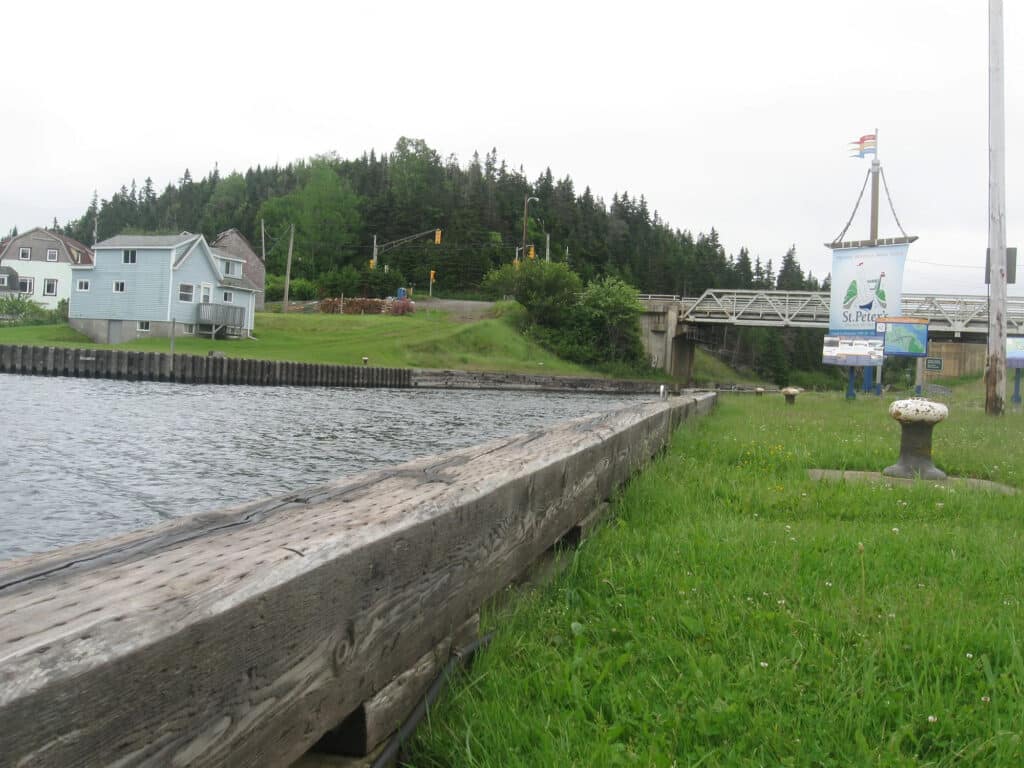
Zartman- canal
We had arrived in Canso with a slight feeling of urgency. Originally we had hoped to be sailing across the Laurentian Trough toward St. Pierre and Miquelon, just off the south coast of Newfoundland, on the longest day of the year; instead, several days after the solstice we were still on the wrong side of Cape Breton Island, and there was squirrely weather on the way. From Ganymede’s deck we could see, over the low seawall, the distant perpetual fog bank that shrouded the way to the Grand Banks. We briefly considered jumping offshore and doing a 320-mile hop to Trepassey Bay, just west of Cape Race on the south shore of Newfoundland, but scuppered that idea after a look at the forecast. Three successive lows, full of rain and wind from all quarters—not strong wind, but shifting enough to make for terribly confused seas. Plan B, to overnight to Louisburg, then proceed to Scatarie Island, Port Morien and thus to Sydney, was scrapped for the same reason: none of the anchorages available is suitable for all winds.
We had not even entertained the idea of transiting the Bras D’or Lakes until it became the only good option—that or stay in Canso, which would not be too sheltered when the wind shifted to north. Once inside the lakes, though, the wind could do what it wanted and we’d be as snug as could be wished.

It was as calm as a millpond as we motored across Chedabucto Bay—what people call a weathermaker in these parts, and though it began to rain as we entered St. Peter’s Canal—a narrow defile blasted through a solid granite ithsmus—the wind held off until the next day. Once through the single lock that gives access to the lakes and past the quaint old swing bridge, we anchored in a good sheltered cove just to port and settled in to wait it out.
We were ineffably glad we did, in the end—not only was the town of St. Peter’s a pleasant place to spend a couple of days, but the weather that came through would have been horrible in any of the other places we might have gone—or in Canso, if we’d stayed put. Happy in our haven, though, I grilled on our charcoal BBQ for the fifth day in a row and rejoiced that we were not tossing about on the Grand Banks among all the fishing boats and fog and oil rigs. We made good time up the lakes, since however hard the wind blew it couldn’t get up any significant seas, and we had a delightful sail across the Great Bras D’or Lake, made more delightful since I managed to get the self-steering vane to work, after a fashion. Though it steered like a pregnant manatee, yawing through a shocking 20 degrees, it did maintain a general course, and we have hopes that with some fiddling it might do better. If only we knew what bit of it to fiddle with.
The town of Baddeck was a disappointment—not only was the only decent anchoring spot chock full of empty mooring balls, a huge placard on shore forbade any anchoring among them. A stupid waste of space, and something we’d hoped to have left behind in the US. Instead we trudged through pelting rain torrents to an admittedly more sheltered spot inside Baddeck Bay, and spent two days looking out the portholes at the driving rain and being very glad to not be out at sea in that kind of frightful wind. It was too far to try and row to town, or land and try to walk, so we never saw it up close.
It wasn’t until Monday that things settled down enough to let us leave, but as the day progressed the clouds finally cleared, and by late morning, as the tide and funneled wind were shooting Ganymede at record speed out the narrow mouth of the great Bras D’or, we saw the long-forgotten sun.

Of course the wind that sped us along so well at first became a tribulation when we had to turn to enter Sydney, and even after we were in the harbor proper it took over an hour to get all the way down to a quiet anchoring spot just at the mouth of the Sydney River. Our collection of photocopied charts did not include a close-up of Sydney harbor, so I had to navigate in using OpenCPN, a program that displays photocopies of charts, running it off of a USB stick on our old laptop, which has more battery life than our new one. It’s an ungainly way to navigate, since you must zoom in so far to see the soundings that you can’t see surrounding features, and scrolling through miles of screen to get to a bit you want to see without losing the scale you want takes ages. Give me a 3’X2’ paper chart any day, that can be plotted on with a pencil, and can be taken all in at a single glance, and takes only temporary harm from a spilled glass of water. But the backup is nice to have for emergencies.
Though it looks a squalid, insalubrious place at first inspection, Sydney has proved a gold mine for things that cruisers need. Tying the dinghy up to a pontoon belonging to the Sydney Dragon Boat club (Dragon boats! Sounds exotic, but they’re really just forty-foot canoes painted with scales, paddled by twenty people to the beat of a drum up in the bows), we jumped the railroad tracks to find a laundry, more fast food places than even Halifax (you can stand at one Tim Horton’s—a sort of Dunkin Donuts—and see two others along the same road), and three grocery stores barely a biscuit-toss apart. So now we’re washed, and fed, and stocked up, and when the weather permits we’ll be off for Newfoundland. Running a little behind, perhaps, but summer seems to be as well, and sailing through the Bras D’or was well worth the extra time.
We are the Zartman family: Ben & Danielle, and our three girls, Antigone, Emily and Damaris. We created this blog to chronicle our sailing adventures on Ganymede, a home-finished 31-foot gaff-rigged cutter, which has been our home since 2009, when we sailed from San Francisco, California, to the Sea of Cortez, then down along the Central American coast. Currently in Newport, Rhode Island, we plan to sail to Canada, the U.K., and beyond this summer.








